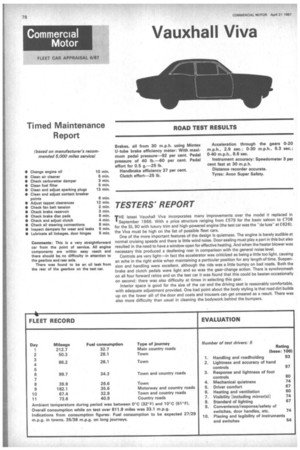TESTERS' REPORT
Page 80

If you've noticed an error in this article please click here to report it so we can fix it.
THE latest Vauxhall Viva incorporates many improvements over the model it replaced in September 1966. With a price structure ranging from £579 for the basic saloon to £708 for the SL 90 with luxury trim and high-powered engine (the test car was the "de luxe" at £626), the Viva must be high on the list of possible fleet cars.
One of the more important features of the design is quietness. The engine is barely audible at normal cruising speeds and there is little wind noise. Door sealing must play a part in this but also resulted in the need to have a window open for effective heating. And when the heater blower was necessary this produced a deafening roar in comparison with the general noise level.
Controls are very light-in fact the accelerator was criticized as being a little too light, causing an ache in the right ankle when maintaining a particular position for any length of time. Suspension and handling were excellent, although the ride was a little bumpy on bad roads. Both the brake and clutch pedals were light and so was the gear-change action. There is synchromesh on all four forward ratios and on the test car it was found that this could be beaten occasionally on second; there was also difficulty at times in selecting this gear.
Interior space is good for the size of the car and the driving seat is reasonably comfortable, with adequate adjustment provided. One bad point about the body styling is that road dirt builds up on the lower sill of the door and coats and trousers can get smeared as a result. There was also more difficulty than usual in cleaning the bodywork behind the bumpers.




































































































































